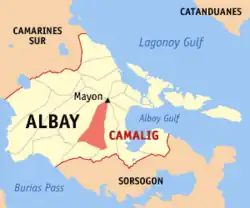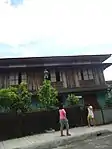Camalig | |
|---|---|
| Municipality of Camalig | |
 Camalig Church and convent | |
 Flag  Seal | |
 Map of Albay with Camalig highlighted | |
OpenStreetMap | |
.svg.png.webp) Camalig Location within the Philippines | |
| Coordinates: 13°08′N 123°40′E / 13.13°N 123.67°E | |
| Country | Philippines |
| Region | Bicol Region |
| Province | Albay |
| District | 2nd district |
| Barangays | 50 (see Barangays) |
| Government | |
| • Type | Sangguniang Bayan |
| • Mayor | Carlos Irwin G. Baldo Jr. |
| • Vice Mayor | Maria Ahrdail G. Baldo |
| • Representative | Jose Ma. Clemente "Joey" S. Salceda |
| • Municipal Council | Members |
| • Electorate | 45,186 voters (2022) |
| Area | |
| • Total | 130.90 km2 (50.54 sq mi) |
| Elevation | 202 m (663 ft) |
| Highest elevation | 770 m (2,530 ft) |
| Lowest elevation | 58 m (190 ft) |
| Population (2020 census)[3] | |
| • Total | 72,042 |
| • Density | 550/km2 (1,400/sq mi) |
| • Households | 17,031 |
| Economy | |
| • Income class | 1st municipal income class |
| • Poverty incidence | 21.05 |
| • Revenue | ₱ 231.5 million (2020) |
| • Assets | ₱ 640.6 million (2020) |
| • Expenditure | ₱ 198.7 million (2020) |
| • Liabilities | ₱ 106.4 million (2020) |
| Service provider | |
| • Electricity | Albay Power and Energy Corporation (APEC) |
| Time zone | UTC+8 (PST) |
| ZIP code | 4502 |
| PSGC | |
| IDD : area code | +63 (0)52 |
| Native languages | Tagalog |
| Website | www |
Camalig, officially the Municipality of Camalig (Central Bikol: Banwaan kan Camalig; Tagalog: Bayan ng Camalig), is a 1st class municipality in the province of Albay, Philippines. According to the 2020 census, it had a population of 72,042 people.[3] It is known for one of Bicol's finest delicacy, Pinangat.
In 1952, there was a mass conversion of certain sitios into barrios (now barangays), namely: Anoling, Binanderahan, Cabraran Pequeño, Cabangan, Ilawod, Mabugna, Magogon, Quinuartilan, Solong, and Sumlang.[5]
Camalig is 12 kilometres (7.5 mi) from Legazpi City and 515 kilometres (320 mi) from Manila.
Geography
According to the Philippine Statistics Authority, the municipality has a land area of 130.90 square kilometres (50.54 sq mi) [6] constituting 5.08% of the 2,575.77-square-kilometre (994.51 sq mi) total area of Albay.
Barangays
Camalig is politically subdivided into 50 barangays.[7] Each barangay consists of puroks and some have sitios.
| PSGC | Barangay | Population | ±% p.a. | |||
|---|---|---|---|---|---|---|
| 2020[3] | 2010[8] | |||||
| 050502001 | Anoling | 1.3% | 964 | 968 | −0.04% | |
| 050502002 | Baligang | 4.7% | 3,389 | 3,286 | 0.31% | |
| 050502003 | Bantonan | 0.8% | 586 | 596 | −0.17% | |
| 050502046 | Barangay 1 (Poblacion) | 1.5% | 1,086 | 828 | 2.75% | |
| 050502047 | Barangay 2 (Poblacion) | 0.6% | 407 | 441 | −0.80% | |
| 050502048 | Barangay 3 (Poblacion) | 0.7% | 534 | 603 | −1.21% | |
| 050502049 | Barangay 4 (Poblacion) | 0.4% | 316 | 371 | −1.59% | |
| 050502050 | Barangay 5 (Poblacion) | 0.5% | 361 | 389 | −0.74% | |
| 050502051 | Barangay 6 (Poblacion) | 0.5% | 385 | 386 | −0.03% | |
| 050502052 | Barangay 7 (Poblacion) | 0.6% | 401 | 483 | −1.84% | |
| 050502004 | Bariw | 2.8% | 2,047 | 1,870 | 0.91% | |
| 050502006 | Binanderahan | 0.8% | 583 | 554 | 0.51% | |
| 050502007 | Binitayan | 0.8% | 590 | 564 | 0.45% | |
| 050502009 | Bongabong | 1.2% | 865 | 917 | −0.58% | |
| 050502010 | Cabagñan | 3.9% | 2,820 | 2,682 | 0.50% | |
| 050502011 | Cabraran Pequeño | 1.2% | 852 | 820 | 0.38% | |
| 050502053 | Caguiba | 2.2% | 1,566 | 1,536 | 0.19% | |
| 050502012 | Calabidongan | 1.0% | 717 | 739 | −0.30% | |
| 050502013 | Comun | 2.4% | 1,704 | 1,547 | 0.97% | |
| 050502014 | Cotmon | 3.8% | 2,750 | 2,507 | 0.93% | |
| 050502015 | Del Rosario | 1.2% | 842 | 824 | 0.22% | |
| 050502016 | Gapo | 2.3% | 1,665 | 1,565 | 0.62% | |
| 050502017 | Gotob | 0.9% | 635 | 647 | −0.19% | |
| 050502018 | Ilawod | 3.9% | 2,807 | 2,684 | 0.45% | |
| 050502019 | Iluluan | 2.3% | 1,631 | 1,293 | 2.35% | |
| 050502021 | Libod | 4.5% | 3,233 | 3,067 | 0.53% | |
| 050502022 | Ligban | 1.0% | 714 | 707 | 0.10% | |
| 050502023 | Mabunga | 0.2% | 137 | 102 | 2.99% | |
| 050502024 | Magogon | 0.8% | 566 | 670 | −1.67% | |
| 050502025 | Manawan | 1.2% | 879 | 833 | 0.54% | |
| 050502026 | Maninila | 1.5% | 1,085 | 984 | 0.98% | |
| 050502027 | Mina | 0.9% | 651 | 627 | 0.38% | |
| 050502028 | Miti | 1.3% | 926 | 893 | 0.36% | |
| 050502029 | Palanog | 4.4% | 3,148 | 2,773 | 1.28% | |
| 050502030 | Panoypoy | 1.8% | 1,304 | 1,329 | −0.19% | |
| 050502031 | Pariaan | 1.2% | 863 | 770 | 1.15% | |
| 050502032 | Quinartilan | 1.3% | 924 | 887 | 0.41% | |
| 050502033 | Quirangay | 3.8% | 2,721 | 2,610 | 0.42% | |
| 050502034 | Quitinday | 0.4% | 259 | 274 | −0.56% | |
| 050502035 | Salugan | 2.4% | 1,750 | 1,688 | 0.36% | |
| 050502036 | Solong | 0.6% | 433 | 488 | −1.19% | |
| 050502037 | Sua | 1.9% | 1,377 | 1,321 | 0.42% | |
| 050502038 | Sumlang | 2.8% | 2,025 | 1,814 | 1.11% | |
| 050502039 | Tagaytay | 7.8% | 5,652 | 5,029 | 1.17% | |
| 050502040 | Tagoytoy | 0.9% | 620 | 684 | −0.98% | |
| 050502041 | Taladong | 2.1% | 1,547 | 1,549 | −0.01% | |
| 050502042 | Taloto | 1.4% | 998 | 1,038 | −0.39% | |
| 050502043 | Taplacon | 1.6% | 1,181 | 1,202 | −0.18% | |
| 050502044 | Tinago | 2.9% | 2,072 | 1,993 | 0.39% | |
| 050502045 | Tumpa | 1.9% | 1,336 | 1,153 | 1.48% | |
| Total | 72,042 | 63,585 | 1.26% | |||
Climate
| Climate data for Camalig, Albay | |||||||||||||
|---|---|---|---|---|---|---|---|---|---|---|---|---|---|
| Month | Jan | Feb | Mar | Apr | May | Jun | Jul | Aug | Sep | Oct | Nov | Dec | Year |
| Mean daily maximum °C (°F) | 26 (79) |
26 (79) |
28 (82) |
29 (84) |
30 (86) |
29 (84) |
29 (84) |
29 (84) |
28 (82) |
28 (82) |
27 (81) |
26 (79) |
28 (82) |
| Mean daily minimum °C (°F) | 22 (72) |
21 (70) |
22 (72) |
23 (73) |
24 (75) |
24 (75) |
24 (75) |
24 (75) |
24 (75) |
24 (75) |
23 (73) |
22 (72) |
23 (74) |
| Average precipitation mm (inches) | 138 (5.4) |
83 (3.3) |
74 (2.9) |
50 (2.0) |
108 (4.3) |
165 (6.5) |
202 (8.0) |
165 (6.5) |
190 (7.5) |
186 (7.3) |
188 (7.4) |
183 (7.2) |
1,732 (68.3) |
| Average rainy days | 16.8 | 11.9 | 13.5 | 13.8 | 20.5 | 25.2 | 27.4 | 26.2 | 26.1 | 24.7 | 20.7 | 18.5 | 245.3 |
| Source: Meteoblue (Use with caution: this is modeled/calculated data, not measured locally.)[9] | |||||||||||||
Demographics
| Year | Pop. | ±% p.a. |
|---|---|---|
| 1903 | 14,153 | — |
| 1918 | 19,772 | +2.25% |
| 1939 | 22,230 | +0.56% |
| 1948 | 25,045 | +1.33% |
| 1960 | 32,002 | +2.06% |
| 1970 | 38,946 | +1.98% |
| 1975 | 41,702 | +1.38% |
| 1980 | 46,040 | +2.00% |
| 1990 | 49,975 | +0.82% |
| 1995 | 53,129 | +1.15% |
| 2000 | 58,141 | +1.95% |
| 2007 | 60,319 | +0.51% |
| 2010 | 63,585 | +1.94% |
| 2015 | 66,904 | +0.97% |
| 2020 | 72,042 | +1.47% |
| Source: Philippine Statistics Authority[10][8][11][12] | ||
In the 2020 census, Camalig had a population of 72,042.[3] The population density was 550 inhabitants per square kilometre (1,400/sq mi).
Economy
Notable personalities
- Domingo Samson – propagandist; Governor of Albay (1908–12)
- Justino Nuyda – zarzuela playwright and congressman
Gallery
 Sumlang Lake
Sumlang Lake Mayon Volcano seen from Camalig
Mayon Volcano seen from Camalig An antique house
An antique house
References
- ↑ Municipality of Camalig | (DILG)
- ↑ "2015 Census of Population, Report No. 3 – Population, Land Area, and Population Density" (PDF). Philippine Statistics Authority. Quezon City, Philippines. August 2016. ISSN 0117-1453. Archived (PDF) from the original on May 25, 2021. Retrieved July 16, 2021.
- 1 2 3 4 Census of Population (2020). "Region V (Bicol Region)". Total Population by Province, City, Municipality and Barangay. Philippine Statistics Authority. Retrieved July 8, 2021.
- ↑ "PSA Releases the 2018 Municipal and City Level Poverty Estimates". Philippine Statistics Authority. December 15, 2021. Retrieved January 22, 2022.
- ↑ "Republic Act No. 735; An Act to Convert the Sitios of Anoling, Binandirahan, Cabraran, Ilawod, Mabugna, Magogon, Quinuartilan, Solong, and Sumlang, in the Municipality of Camalig, Province of Albay, to Barrios of the Same Municipality". The Corpus Juris. June 18, 1952. Archived from the original on October 23, 2016. Retrieved October 23, 2016.
- ↑ "Province: Albay". PSGC Interactive. Quezon City, Philippines: Philippine Statistics Authority. Retrieved November 12, 2016.
- ↑ "Municipal: Camalig". PSGC Interactive. Quezon City, Philippines: Philippine Statistics Authority. Retrieved January 8, 2016.
- 1 2 Census of Population and Housing (2010). "Region V (Bicol Region)" (PDF). Total Population by Province, City, Municipality and Barangay. National Statistics Office. Retrieved June 29, 2016.
- ↑ "Camalig, Albay : Average Temperatures and Rainfall". Meteoblue. Retrieved December 29, 2018.
- ↑ Census of Population (2015). "Region V (Bicol Region)". Total Population by Province, City, Municipality and Barangay. Philippine Statistics Authority. Retrieved June 20, 2016.
- ↑ Censuses of Population (1903–2007). "Region V (Bicol Region)". Table 1. Population Enumerated in Various Censuses by Province/Highly Urbanized City: 1903 to 2007. National Statistics Office.
{{cite encyclopedia}}: CS1 maint: numeric names: authors list (link) - ↑ "Province of Albay". Municipality Population Data. Local Water Utilities Administration Research Division. Retrieved December 17, 2016.
- ↑ "Poverty incidence (PI):". Philippine Statistics Authority. Retrieved December 28, 2020.
- ↑ "Estimation of Local Poverty in the Philippines" (PDF). Philippine Statistics Authority. November 29, 2005.
- ↑ "2003 City and Municipal Level Poverty Estimates" (PDF). Philippine Statistics Authority. March 23, 2009.
- ↑ "City and Municipal Level Poverty Estimates; 2006 and 2009" (PDF). Philippine Statistics Authority. August 3, 2012.
- ↑ "2012 Municipal and City Level Poverty Estimates" (PDF). Philippine Statistics Authority. May 31, 2016.
- ↑ "Municipal and City Level Small Area Poverty Estimates; 2009, 2012 and 2015". Philippine Statistics Authority. July 10, 2019.
- ↑ "PSA Releases the 2018 Municipal and City Level Poverty Estimates". Philippine Statistics Authority. December 15, 2021. Retrieved January 22, 2022.
External links
 Media related to Camalig at Wikimedia Commons
Media related to Camalig at Wikimedia Commons- Philippine Standard Geographic Code